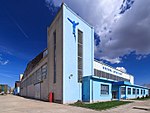Pipera Airport
1958 disestablishments in RomaniaAC with 0 elementsAirports in RomaniaBuildings and structures in BucharestTransport in Bucharest

Bucharest Pipera Airfield was located in the Pipera neighborhood of Bucharest, Romania, at the northern edge of the city, right next to the town of Voluntari, Ilfov County. The airport no longer exists. A small military base, which also hosts the Aviation Museum of Bucharest, remains in the location where the airport used to be.
Excerpt from the Wikipedia article Pipera Airport (License: CC BY-SA 3.0, Authors, Images).Pipera Airport
Șoseaua Fabrica de Glucoză, Bucharest
Geographical coordinates (GPS) Address Phone number Website Nearby Places Show on map
Geographical coordinates (GPS)
| Latitude | Longitude |
|---|---|
| N 44.478055555556 ° | E 26.111111111111 ° |
Address
Muzeul Aviației
Șoseaua Fabrica de Glucoză 2-4
013695 Bucharest (Sector 2)
Romania
Open on Google Maps






